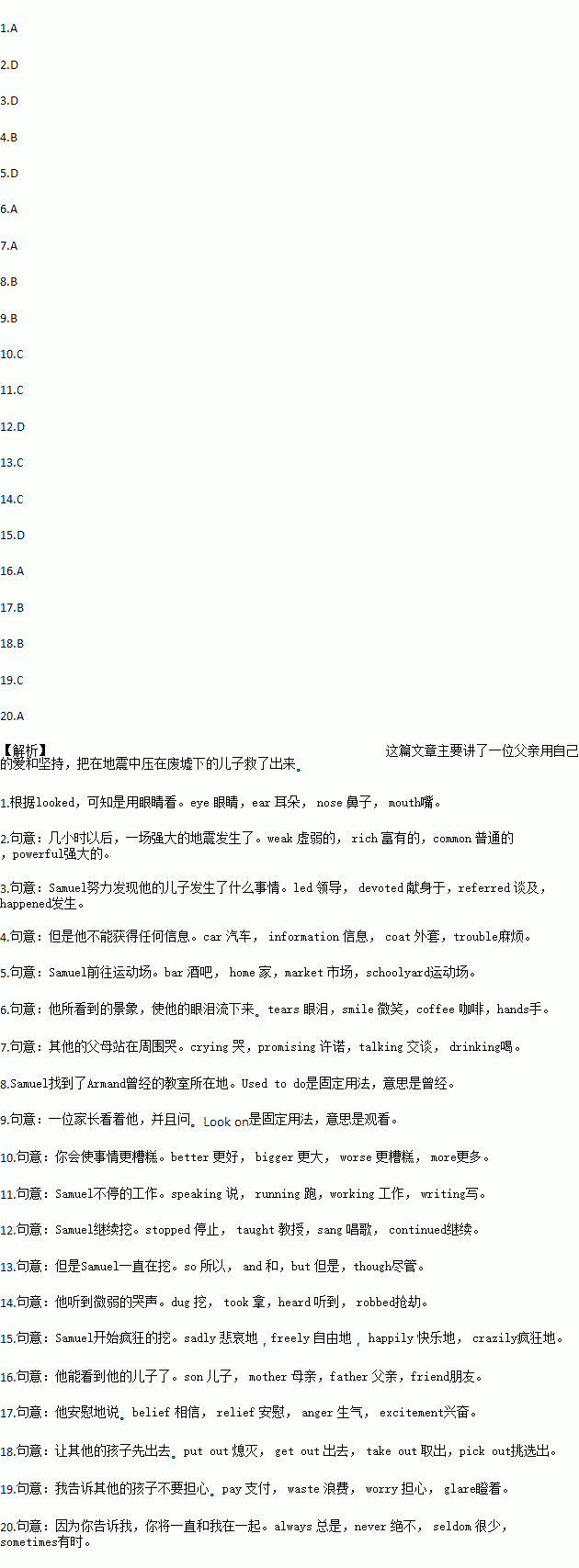题目内容
In America, in 1988, Samuel sent his son, Armand, to school. Samuel hugged the boy and looked him in the ______,“Have a good day, and remember, I’ll always be there for you.”
Hours later, a ______ earthquake happened. Samuel tried to discover what ______ to his son, but he couldn’t get any ______, Samuel then headed for the ______. When he reached the area, what he saw brought ______ to his eyes. Armand’s school was a pile of debris (残骸). Other parents were standing around ______.
Samuel found where Armand’s classroom ______ to be and began pulling a broken rock off the pile and put it to the side, and then grabbed another one.
One of the parents looking ______ asked, “What are you doing?”
“Digging for my son,” Samuel answered. The man then said, “You will make things ______! The building is unstable.” He tried to stop Samuel.
Samuel just kept ______. As time went on, one by one, the other parents left.
All through the night and into the next day, Samuel ______ digging. Parents placed flowers and pictures of their children on the ruins, ______ Samuel just kept doing. Suddenly, he ______ a faint cry. “Help! Help!” Samuel listened but didn’t hear anything again. Then he heard a muffled (闷声的) voice, “Papa?”
Samuel began to dig ______. At last, he could see his ______. “Come on out, son!” he said with ______.
“No,” Armand said. “Let the other kids ______ first because I know you’ll get me.”
All 14 children were alive. Samuel took his son in his arms and Armand said, “I told the other kids not to ______ because you told me that you’d ______ be there for me.”
1.A. eye B. ear C. nose D. mouth
2.A. weak B. rich C. common D. powerful
3.A. led B. devoted C. referred D. happened
4.A. car B. information C. coat D. trouble
5.A. bar B. home C. market D. schoolyard
6.A. tears B. smile C. coffee D. hands
7.A. crying B. promising C. talking D. drinking
8.A. seen B. used C. wanted D. responded
9.A. at B. on C. after D. down
10.A. better B. bigger C. worse D. more
11.A. speaking B. running C. working D. writing
12.A. stopped B. taught C. sang D. continued
13.A. so B. and C. but D. though
14.A. dug B. took C. heard D. robbed
15.A. sadly B. freely C. happily D. crazily
16.A. son B. mother C. father D. friend
17.A. belief B. relief C. anger D. excitement
18.A. put out B. get out C. take out D. pick out
19.A. pay B. waste C. worry D. glare
20.A. always B. never C. seldom D. sometimes

